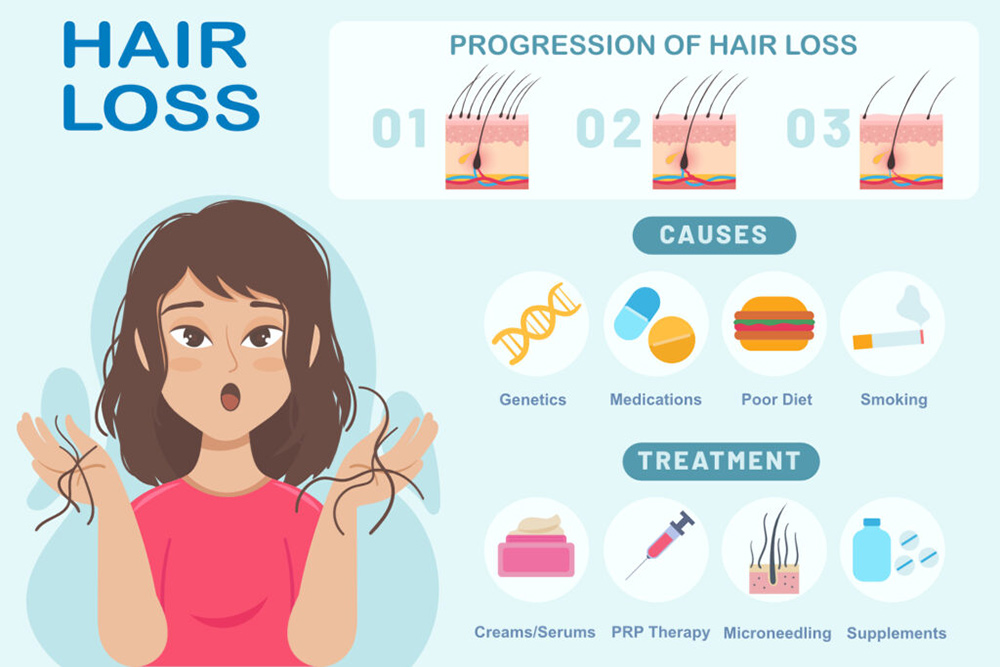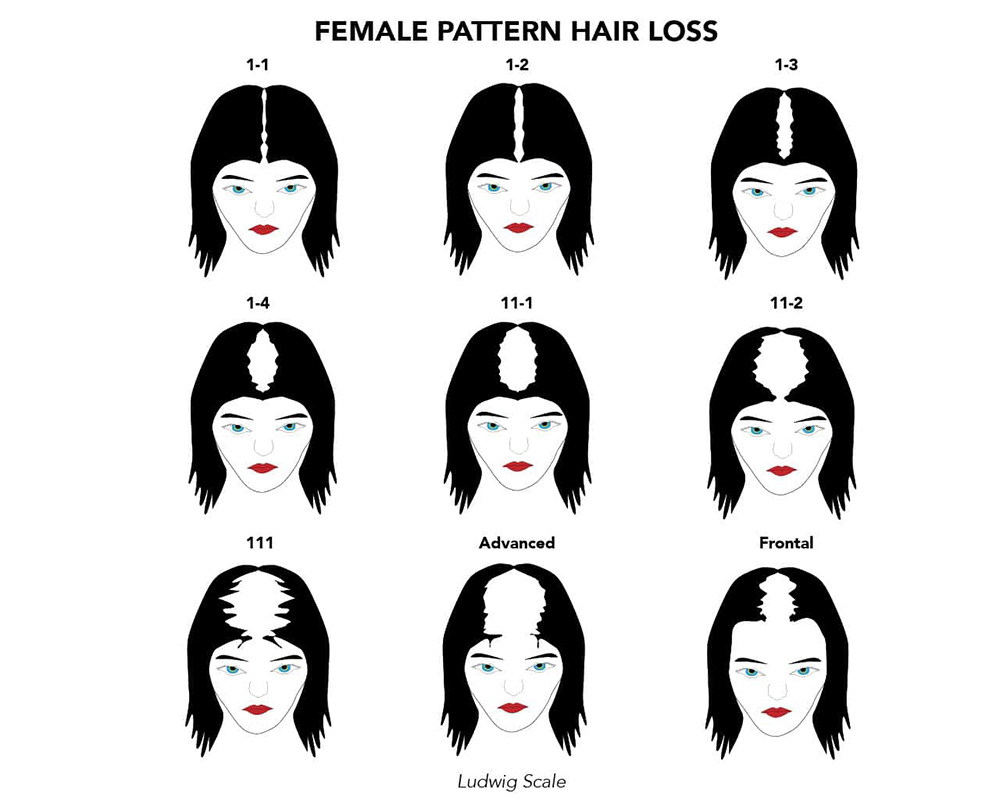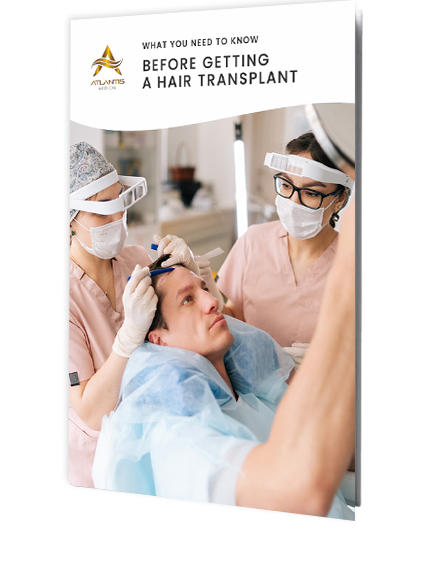Female Pattern Baldness: Causes, Solutions and Everything You Need to Know
- June 10, 2025
- Dr. Vikram Jayaprakash
Last updated on June 10, 2025
Hair loss in women is more common than many people realise, but it often presents very differently from male pattern baldness. While men typically experience receding hairlines or bald patches, women are more likely to notice gradual thinning, reduced volume or a widening part. These changes can be subtle at first, but over time, they can have a real impact on scalp health and hair density.
Understanding what causes hair loss in females is the first step towards addressing it. Whether you’re experiencing increased shedding, noticing changes in your part line, or simply want to be proactive about your hair health, this guide will break down the most common causes and practical solutions available.
Table of Contents
ToggleThe Most Common Types of Hair Loss in Females
Hair loss in women can occur in different forms, each with unique causes and patterns:
- Female Pattern Baldness (Androgenetic Alopecia): The most common type, linked to genetics and androgen sensitivity. It causes gradual thinning through the crown and mid-scalp, often without a receding hairline.
- Telogen Effluvium: A temporary form of shedding triggered by stress, illness, or major life changes. It usually resolves once the underlying cause is addressed.
- Alopecia Areata: An autoimmune condition that causes patchy hair loss on the scalp or body. It may come and go over time.
- Traction Alopecia: Caused by tight hairstyles that pull on the hair over time, leading to thinning or breakage, often around the hairline.
- Hormonal Hair Loss: Hormonal fluctuations during pregnancy, menopause or from conditions like PCOS can disrupt hair growth. This type often overlaps with other forms of hair loss.
Each type requires a tailored approach. Understanding the pattern is key to finding the right treatment.

What Causes Hair Loss in Females?
Multiple factors often combine to trigger or worsen female hair loss:
- Genetics: A family history of thinning hair, especially after menopause, can increase the risk of female pattern baldness.
- Hormonal Imbalance: Changes related to pregnancy, menopause, thyroid issues or PCOS can affect the hair cycle and slow regrowth.
- Nutritional Deficiencies: Low levels of iron, vitamin D, or protein can weaken hair structure and contribute to thinning.
- Stress and Illness: Physical or emotional stress can push hair into a resting phase, causing temporary shedding known as telogen effluvium.
- Hairstyling Habits: Frequent use of heat tools, chemical treatments or tight hairstyles may damage follicles and accelerate thinning.
- Medical Conditions: Autoimmune disorders, chronic inflammation, or scalp infections can also disrupt hair growth.
Identifying the underlying cause is vital for developing a treatment plan that works. In many cases, it’s not about a single issue, but a combination of factors that must be addressed together.
How to Tell If You’re Experiencing Female Pattern Hair Loss
Female pattern baldness tends to appear gradually. Some of the most common early signs include:
- A widening part through the centre of the scalp
- Noticeable thinning around the crown or mid-scalp
- Reduced volume, especially when styling or tying hair back
- Increased hair fall in brushes, pillows or shower drains
Because it doesn’t typically cause bald patches, this condition can go unnoticed until hair density has significantly reduced. A professional assessment can help determine whether the thinning is temporary or progressive.

Myths vs Facts About Female Hair Loss
There’s no shortage of misinformation online when it comes to hair loss. Here are a few common myths and the facts behind them:
Myth: “Only men experience genetic hair loss.”
Fact: Female pattern baldness is genetic and affects millions of women worldwide.
Myth: “Washing your hair too often causes it to fall out.”
Fact: Hair naturally sheds each day. Washing simply dislodges hair that was already ready to fall.
Myth: “Hair loss is always permanent.”
Fact: Some forms, like telogen effluvium or nutrient-related loss, can be reversible with the right care.
Myth: “Supplements can regrow hair overnight.”
Fact: While supplements may support scalp health, results take time and should be tailored to deficiencies.
Treatment Options
There is no one-size-fits-all solution for female hair loss, but a combination of treatments often delivers the most sustainable results. Common treatment pathways include:
Medical Therapies
Certain prescription medications can help slow hair loss or support regrowth. These are most effective when hair loss is hormonally driven or caught early.
Non-Surgical Treatments
Topical solutions, nutrient support and scalp therapies are often used to improve follicle function and maintain hair density.
Hair Transplant Surgery
For some women, hair transplantation may be an option. This involves relocating hair follicles from denser areas to visibly thinning zones. It’s best considered when hair loss is stable and localised.
Conclusion: Knowledge Is Power
Hair loss in women is complex and no two cases are exactly alike. By understanding what causes hair loss in females and recognising the early signs, you can take proactive steps to preserve your hair and protect your long-term scalp health.
Whether you’re just starting to notice changes or looking for a more structured solution, seeking medical advice can help you move forward with clarity and confidence. Female hair loss isn’t something you need to manage alone — professional support and scientifically backed treatments are available to guide the way.
How to Book a Consultation
Booking your consultation is simple.
- Call us on (03) 9070 5234
- Contact us via our website
- Email us at enquiries@atlantismedical.com.au
- Or visit us at Level 2, 148 Glenferrie Road, Malvern, Vic 3144
Opening Hours
Mon – Fri: 8:30am – 5:00pm
Sat – Sun: Closed
Frequently Asked Questions
What causes hair loss in females?
Hair loss in women can be caused by genetics, hormonal changes, stress, nutritional deficiencies, or medical conditions. Often, multiple factors are involved.
How can I tell if I have female pattern baldness?
Common signs include a widening part, thinning at the crown and reduced hair volume. Unlike male baldness, the hairline typically stays intact.
Can hair loss in women be reversed?
Some types, like stress-related or nutrient-deficient hair loss, can be reversed. Female pattern baldness can be managed but not fully reversed.
Is female hair loss always permanent?
No. Temporary forms like telogen effluvium often resolve once the trigger is removed. A professional diagnosis helps determine if treatment is needed.
What is the best treatment for female hair loss?
The best treatment depends on the cause. Options may include medical therapies, non-surgical treatments, or hair transplant procedures in suitable cases.
Any surgical or invasive procedure carries risks. Before proceeding, you should seek a second opinion from an appropriately qualified health practitioner.

About the Author
Dr. Vikram Jayaprakash
Dr. Vikram Jayaprakash is the Clinical Director of Atlantis Medical, one of Melbourne’s premier hair restoration clinics. Trained at the University of Southampton Medical School, he spent over a decade working alongside Dr. Russell Knudsen at the renowned Knudsen Clinic before establishing his own practice. As one of only three doctors in Australia to hold Board Certification from The American Board of Hair Restoration Surgery and one of two to attain Fellowship status with the International Society of Hair Restoration Surgery, Dr. Jayaprakash brings unparalleled expertise to every procedure.
Categories
Categories
- Female Hair Loss (5)
- General (3)
- Hair Health (3)
- Hair Loss (9)
- Hair Loss Treatment (7)
- Hair Transplant (18)
- Male Hair Loss (8)
- Non Surgical Treatments (1)
- Scalp Health (1)






